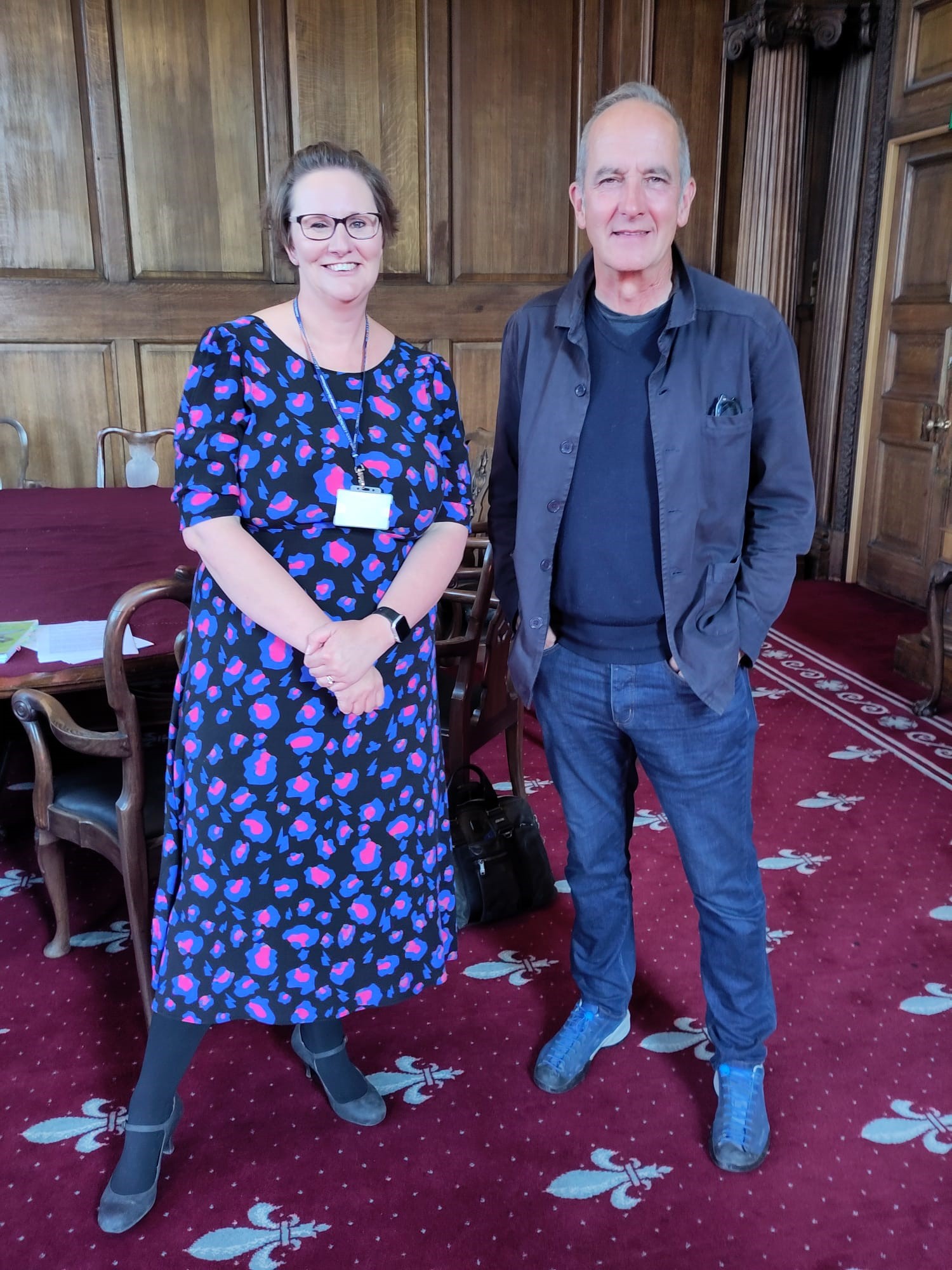20 Sep 2024
How is Action 5 tackling the climate crisis?
To play their full part in delivering national and local climate targets, councils will need to embed climate action across all their policies and strategies, particularly in crucial areas such as transport, economic development, housing and planning. In 2020 Lancaster City Council began a climate emergency review of its Local Plan, ensuring that climate-conscious placemaking is a fundamental part of the district's future.
Local Plans guide the location and design of new development in an area, and so influence how people travel, whether new buildings are energy efficient and where space can be found for renewable energy. Although Local Plans are legally required to include policies that "contribute" to climate change mitigation and adaptation, they don't have to be aligned with net zero targets. The UK government needs to change this to ensure all planning policies and decisions align with legally binding net zero targets. But Lancaster City Council hasn't waited for national change and has gone beyond what's currently required.
Lancaster’s recognition that planning policy must be more ambitious on meeting climate goals is supported by the government’s own advisors. The Climate Change Committee (CCC) reported in 2020 that most Local Plans require "significant revision" if net zero is to be delivered. In 2021 the Committee recommended that a "net zero test" be applied to planning. And in 2022 it reported that local government "is still not sufficiently supported" with "insufficient progress" made on reforming planning standards. This was echoed by an independent review led by Chris Skidmore MP, which found that the current planning system is “undermining net zero and the economic opportunities that come with it” in the absence of alignment with climate goals.
It’s anticipated that most of Lancaster’s proposed changes featured in this case study will be accepted with minor modifications, but the national Planning Inspectorate (PINS) challenged its ambitious policy for net zero housing (DM30a), despite it being similar to policies adopted in Local Plans elsewhere. Now, a recent written ministerial statement on energy efficiency standards has caused further uncertainty and delay for Lancaster and other councils developing ambitious policies (more detail below). Lancaster, however, remains committed to strong local policies on climate and nature.
Steps in the review
Like dozens of other local authorities across the UK, in 2019 Lancaster declared a climate emergency. In July 2020 the council adopted its new Local Plan, which had been in development for 8 years. Yet Lancaster then took the unprecedented decision to launch straight into its climate emergency review of the Local Plan.
"It cannot be overstated how important the Local Plan is as a document that guides development in the district. Through this partial review of the Local Plan, we are aiming to have the right policies in place to take action on the climate emergency and make sure that wherever possible it's promoting low carbon and is fit for the future."
Councillor Gina Dowding, Cabinet Member for Planning and Placemaking, Lancaster City Council
Two documents make up the Lancaster Local Plan: the Strategic Policies & Land Allocations Development Plan Document (DPD) and the Development Management DPD. An initial scoping consultation took place between September and November 2020 to establish exactly what the climate emergency review should investigate, since it wasn't the intention to rewrite the entire Local Plan. Thirty-two policies were selected for possible amendment to address climate change adaptation and mitigation across 5 key themes:
- Water management
- Green and blue infrastructure
- Heritage
- Transport
- Sustainable design, energy efficiency and renewable energy.
A revised draft of the Local Plan was ready within a year and went out to consultation for the community's feedback between July and September 2021. The council proactively embraced positive community engagement to ensure that changes made to the plan were supported and shaped by the district's residents. There was a final opportunity for public input between January and March 2022, after which the new climate-focused Local Plan was submitted to the Secretary of State for the appointment of an Inspector to carry out an examination of the plan.
Hearings with the Inspector were held in October 2022, and in November that year the Inspector challenged the proposed sustainable design policy (DM30a) for not being “consistent” with national policy. The council repeatedly defended its policy but was forced to modify it in June 2023. This also sparked a wider debate on the issue and a series of legal challenges (see below for more detail). The debate continued into 2024 because the government issued a new written ministerial statement on energy efficiency standards in late 2023.
What impact has the project had?
Lancaster has both strengthened existing policies and introduced new ones as a result of its Climate Emergency Local Plan Review. Some of the headline changes that are likely to be adopted without modification or with only minor modification by the independent examination process are:
Responding to climate change and creating environmental sustainability (Strategic Policy CC1): This is a new, overarching strategic policy that responds to the council's declaration of a climate emergency and its ambition to reduce emissions to net zero by 2030. The policy sets out the future vision for a climate-resilient Lancaster District and the expectation that all new developments will address environmental and climate impacts from the outset.
The climate emergency review has also updated the economic objective of the Local Plan from "growth" to "prosperity," reflecting the idea that growth based on extraction isn't a sustainable way to live within planetary boundaries.
Retrofitting historic buildings (Development Management policies DMCCH1 and DMCCH2): This allows for the retrofit and installation of micro-renewables in historic buildings. Lancaster has many traditional stone masonry buildings that are heritage assets. These 2 new policies, written with input from Historic England (an executive non-departmental public body), support responsible retrofit so that housing with historical value can maintain its original character while also cutting carbon emissions.
Walking and cycling provision (Development Management Policy DM61): This policy prioritises walking and cycling. Updated transport policies in the Local Plan now aim to achieve a "modal shift" away from private car use towards accessible active and sustainable travel options – creating new walking and cycling networks is crucial for this.
Green and blue infrastructure (Strategic Policy SC4 and Development Management Policy DM43): These policies refer to green and blue spaces (like rivers, ponds and lakes) and have been updated to give greater emphasis to the connectivity of green and blue infrastructure. There's also a new emphasis on the quality, role and value of green and blue spaces, including their role in climate mitigation and adaptation, recreation, active travel, water management, landscape and biodiversity. These must be considered in the design of new development.
The council will strongly resist any proposal that involves the loss of such spaces. It produced a Green and Blue Infrastructure Strategy to support these policy changes, and has even created a toolkit to help developers incorporate green and blue spaces into their designs.
Minimising waste and material use (Development Management Policy DM30c): This policy refers to material use and waste during construction. Under the revised policy, developers must consider the lifecycle carbon emissions of new buildings, from concept to demolition. Where possible, local suppliers and low-carbon materials should be used. Reuse and recycling of construction materials is expected. Addressing lifecycle emissions is a progressive policy that'll help to reduce embodied carbon, a significant source of emissions that's currently unregulated in the UK.
Water management and flood risk (Development Policy DM34): This updated policy is about water management. It prioritises reusing water as well as sustainable drainage systems (SuDS) to reduce flood risk. The original version of this policy encouraged sustainable drainage, but the review has upgraded this "encouragement" to become a policy requirement. The revised policy will require all proposals for new developments to incorporate SuDS and face stricter assessments of flood risk. Under the proposed new policy, more developments will also need to supply a sustainable drainage strategy including any residential development over 5 units. Previously this would have only applied to "major development".
Renewable energy generation (Development Management Policy DM53): National planning policy sets an extremely high bar for onshore wind developments. In the submission version of the Climate Emergency Local Plan Review, like a minority of other councils Lancaster took a proactive approach to enable wind energy generation in its area, by including a "wind energy opportunity area" map in the Local Plan – unlocking potential where others have only seen barriers. Unfortunately, the Inspector requested a main modification to revert to the wind energy constraints plan that was included in the adopted Local Plan, but the council intends to assess the potential opportunities for wind energy generation further in its Full Local Plan Review. New policies regarding energy storage have also been added, including a requirement for a decommissioning plan for battery storage facilities, which will ensure safety elements are adequately considered. This is important because the UK will need more storage capacity in the future so that energy can be released when needed most. Yet not many, if any, Local Plans are addressing this.
Leading the way on zero-carbon housing
Lancaster put forward an ambitious policy for new buildings: Sustainable design and construction (Development Management Policy DM30a). This has unfortunately been challenged by the Planning Inspectorate, but Lancaster has continued to make the case for an ambitious policy.
The new policy focused on sustainable design and construction and was a major change to the adopted Local Plan. It supported a fabric first approach, meaning all new buildings must have high levels of insulation and energy efficiency. The policy also highlighted the need to mitigate for overheating through, for example, the inclusion of shading and consideration for the appropriate orientation of buildings.
The Climate Emergency Local Plan Review originally proposed that all new developments must achieve a minimum 31% reduction in carbon emissions at plan adoption and increase to a 75% reduction by 2025. The emissions reductions were in line with the new Future Homes Standard proposed by the government but required that emissions reductions are initially done through a fabric first approach. Lancaster's proposed draft policy also went further than national government by setting out that by 2028 all new developments must be net zero carbon from day one rather than "zero carbon ready," which is the government's approach and relies on the decarbonisation of the national grid. Lancaster’s approach requires highly energy-efficient buildings as well as on-site renewable energy or an off-site renewable energy source so that emissions are zero or even negative (ie generating a surplus of renewable energy).
Unfortunately, this policy was challenged by the Inspector during the Local Plan Review examination. PINS’ view was that Lancaster's policy wasn’t compliant with national policy. However, its reasoning was based on an out-of-date 2015 written ministerial statement and didn’t take into account that similar policies had already been adopted by other local planning authorities, and that more recent guidance supported local planning authorities to go beyond national building regulation standards. Lancaster steadfastly defended its policy but was forced to modify it in June 2023, weakening its ambition to require net zero housing by 2028. When the council carried out a public consultation on the modification (Main Modification 14), it received an overwhelming response in support of keeping the original policy, with over 500 people responding and 99% in favour of the more ambitious policy. The support came from around the UK showing that this isn’t just a local issue.
In December 2023 the government issued a new written ministerial statement which creates more confusion than clarity and threatens to stifle local ambition. It states that the “government does not expect plan-makers to set energy efficiency standards for buildings that go beyond current or planned building regulations”. While this may have seemed like a final nail in the coffin for Lancaster’s ambitious policy, the statement does allow local planning authorities to go beyond national standards if they’re able to demonstrate viability and use the government’s preferred metric, the Target Emissions Rate (TER), which is based on carbon emissions. Lancaster is confident that it can demonstrate viability from the evidence that it gathered on the original policy. The council has also drafted a new policy based on TER, but its preferred option would be a policy based on Energy Intensity Use (EIU) reduction. One of the key advantages of the EIU metric is that it ensures energy efficiency as well as carbon reduction, meaning it tackles fuel poverty (ie the cost of heating a dwelling) too. On the other hand, by only concentrating on emissions as TER does, a house could be part-powered by solar panels but still leak heat and be expensive to run.
Lancaster is determined to have a policy that’s as ambitious as possible. While the climate emergency partial review will conclude in 2024, the council has also commenced a Full Local Plan Review and will continue to pursue the best possible sustainable design and construction policy within the acknowledged constraints of national policy. It may be assisted, albeit indirectly, by the outcome of a legal challenge to last year’s written ministerial statement launched in February 2024 by the Good Law Project and Rights Community Action. Progressive councils like Lancaster are helping to inform and inspire national campaigns, and Lancaster Council’s Principal Planning Policy Officer, Diane Neville, even featured in Channel 4’s “The Great Climate Fight”. The Plan, and its approach to policy making, has been shortlisted for a national award in the LGC Awards 2024 net zero category, and Diane was also recently named as one of The Planner’s Women of Influence 2024 for her work fighting for local energy efficiency standards.
"Despite the rapid production of the Climate Energy Local Plan Review itself (only 19 months from inception to submission), the road to adoption has not been a straightforward one. Following the Planning Inspector’s contradictory decision in the post-hearing letters, in an effort to push for higher energy efficiency standards the team have spent 2023 pushing for change to raise awareness of the inconsistency of decision making being taken by central government on this issue. The team have appeared at many events over the past year, spreading word on the issue of energy efficiency in new homes and planning policy; and networked tirelessly with other local authorities as well as MPs from all across the country to raise awareness of the obstacles that local authorities face when dealing with the policies of national government."
Diane Neville, Principal Planning Policy Officer, Lancaster City Council
Other projects
Lancaster isn't only looking at its Local Plan to promote planning as the key to unlocking truly transformative climate action. It's also participating in other projects that link planning and the climate emergency.
- In May 2022 a joint research project between Lancaster University and the city council was launched, called "Placemaking with Young Adults". The project invites 18–30-year-olds to share their views on sustainability, allowing young adults and policymakers to talk directly to each other and co-design policies for Lancaster's future.
- The Rurban Hope Spots project, a collaboration between Friends of the Earth, the city council, Lancaster University, FoodFutures and the Urban Agriculture Consortium, was launched in June 2022. Its focus is on how to overcome a major barrier to community food growing: land availability. This project investigates how data and mapping can help communities access land suitable for food growing.
Lancaster’s ambitious approach has been recognised in Climate Emergency UK’s assessment of councils on their efforts to decarbonise. The council scored a total of 61%, making it the top performing district council in the country.
What made this work?
Political courage and commitment. At the time of Lancaster's climate emergency declaration, the new Local Plan was already close to completion, a process that had taken almost a decade. It wasn't possible to start from scratch. But elected members didn't take this as an excuse and recognised that something had to be done. As the major document dictating the future of local authority areas, climate change needed to be central to the Local Plan going forward.
Its elected members initiated the Climate Emergency Local Plan Review from the top down, and they continue to back it even through political changes. The 2021 local elections left the council under no overall control by a single party. Lancaster's engaged and concerned councillors, representing all parties, have wholeheartedly supported the Local Plan review process. Lancaster is working to reject adversarial politics and embrace consensual politics.
This political commitment has continued through a tricky period of the Local Plan Review, standing up for a strong net zero housing policy despite the Inspector’s criticisms and unhelpful national policy shifts.
Strong community engagement. Planning influences the shape of the places we live in. Communities therefore deserve a say, but often find planning dry and complex to understand. Lancaster wanted to have dynamic conversations with residents, so it planned its community engagement carefully along the principle of meeting people where they're at. Having a creative and committed consultation officer also boosted this.
"Planning consultations are generally pretty dry and you have to be a certain type of person to turn up to a church hall on a winter's night to look at planning boards. That's how it's always been done, but [the Climate Emergency Local Plan Review] really pushed us to do things differently. We wanted to try and get younger people involved, because this is their lives and will affect them the most. As part of the Climate Emergency Local Plan Review, we worked with primary schools, community groups, held events in the charter market, and worked with Lancaster University to ensure the voice of young adults was heard in our policy making."
Diane Neville, Principal Planning Policy Officer, Lancaster City Council
Due to pandemic constraints, consultation was hybrid, taking place online but also reaching people through outdoor events such as the Great Big Green Week and events around COP26. This meant residents didn't have to attend a designated planning event and the council was able to reach people who wouldn't otherwise actively seek to participate.
Lancaster also found that digital engagement reached more – and different – people than usual. Using multiple different digital platforms meant the council could engage people whatever their preferred platform. Lancaster also created interactive digital storyboards and explanatory videos that used simple language and visual aids to make the process clear. The council wanted to tell a story that everyone could engage with. For instance, the review was framed as "having your say on how the city council should tackle climate change", rather than the technicalities of Local Plan regulations.
Lancaster's community engagement plan included briefings to elected members, so that they could confidently discuss the review with residents. Briefings were made to the local press. Additionally, 500 leaflets featuring a QR code that linked directly to the Local Plan consultation were distributed at events, schools, businesses, doctors' surgeries and care homes. The council also reached out to community groups like FoodFutures.
Being prepared for objections and the "viability argument". Lancaster knew that a major barrier could be the objections of developers and construction firms, and so made sure to pragmatically engage these stakeholders. Part of this involved being prepared for the "viability argument" – ie complaints that proposed policies would not be financially viable. Council officers appointed specialist consultants Three Dragons to conduct an independent viability assessment to ensure that all proposed policies were viable. Three Dragons were therefore on board from the start.
The viability assessment process included engaging with industry around the issue. During the consultation period, the council received a response relating to viability from a consortium of 8 developers. Over 350 industry representatives were then invited to an engagement event in summer 2021.
Responding to developers' concerns by drawing on evidence provided by Three Dragons, the council pointed out that improving building performance may increase up-front costs but no more than the cost uplift for delivering the new 2021 building regulations. The council was also able to highlight that the fabric first approach should significantly reduce ongoing running costs, and that this should be factored into arguments about viability. Policy DM30a (sustainable design and construction) takes a fabric first approach – this prioritises reducing energy demand, which in turn minimises the impact on viability. It also has a phased introduction to allow developers time to adapt. The council’s strong evidence on viability will be essential in continuing to make the case for a strong net zero housing policy, as this is one of the requirements of the new written ministerial statement.
Cross-departmental and cross-boundary working. Within the council, the planning, climate and heritage teams have worked together closely to draw up new policies. Planning officers have also collaborated with Lancashire County Council, the highways authority for the area, on transport policies. The desired modal shift that Lancaster is seeking won't be possible without the county's input.
What resources were needed?
The Climate Emergency Local Plan Review was funded internally from the council's own budget. The cost of completing the partial review was lowered by choosing to conduct much of the evidence base work in-house, rather than going out to consultants. To do this, 2 new specialist Climate Change Policy Officers, based in the planning team, were hired to support the Local Plan review.
While waiting for the existing Local Plan to be adopted, behind-the-scenes work to get ready for an immediate climate emergency review started in early 2020. Timescales were sketched out, the 2 new officer posts were integrated, and an internal Local Plan review group of elected members was formed.
Lessons from Lancaster
National planning reform is needed. A lack of clarity in national policy, the confusion caused by the new written ministerial statement issued in 2023, and inconsistency from the Planning Inspectorate has hindered the net zero ambitions of Lancaster and other local planning authorities. Council officers fear work going to waste if they're unable to defend higher than national standards to inspectors in future planning decisions. This is especially the case in the context of perceived competing tensions between climate emergency objectives and the emphasis on building new homes. However, with the right policies in place, ensuring there are enough affordable, quality homes and protecting the environment aren't mutually exclusive. The UK government must reform the planning system so that it's fully aligned with tackling the climate emergency.
"We're not the first ones to look at climate change or optional energy efficiency standards, but we are the first to take a sound Local Plan that's brand new and re-look at it to specifically address the climate emergency. The Climate Emergency Local Plan Review predominantly impacts on new development, but that new development may be there for the next hundred plus years. So, it's not just the impact today we're looking at, but impact for future generations. Our focus is not just on emissions. For example, we want high energy efficiency homes so there aren't any more houses built in the district that trap people into fuel poverty, which is highlighted with the energy crisis. We also want to create the climate resilience that the district absolutely has to have, as a coastal community in particular."
Susanna Dart, Climate Change Policy Officer, Lancaster City Council
Keep it focused. When amending an already adopted Local Plan to account for the climate emergency, a total rewrite is unfeasible. Lancaster chose areas that would have the most impact and that were locally relevant. It's a diverse district that includes urban, coastal and rural areas, with a high number of historic stonewalled properties. Lancaster's also felt climate impacts in the form of severe flooding in recent years. Consequently, the Climate Emergency Local Plan Review prioritised themes of water management, retrofit in heritage settings and improving rural transport connectivity.
Ambition keeps timelines short. Lancaster's example shows that, if driven by ambition, other councils could implement a Local Plan review in a short timeframe. Lancaster was able to reach the public consultation in under a year, and the whole process to submission stage has taken just 20 months.
Bring developers along with you. Lancaster made a concerted effort to prove to developers that doing things differently isn't necessarily more expensive or onerous, just different. Using external witnesses and experts was crucial in communicating that the direction of travel is towards climate-friendly development anyway, so developers won't be harmed in the long run. Lancaster also made the comparison to requirements for affordable housing, which over time have become more accepted by developers, suggesting that climate policies will follow the same trajectory.
Lancaster produced many supporting documents to ease the concerns of developers. One example is its User Guide to the new sustainable design and construction Policy DM30a, which includes supportive quotes from local firms such as Bloor Homes, Green Rose and Tyson Construction.
Collaborate with other councils. Progressive councils should not feel alone, as officers can learn from their peers at other authorities. Lancaster reached out to Cornwall Council and looked into planning innovations at other councils such as Bristol and York. Since embarking on the Climate Emergency Local Plan Review, Lancaster has already been frequently approached to help advise other authorities inspired by its example. With the challenges caused by inconsistency from the Planning Inspectorate and the confusion caused by the new written ministerial statement, it’s been more important than ever for local planning authorities to work together, as well as with national organisations like the Town and Country Planning Association, to make the case for councils being able to set high energy efficiency standards for new buildings.
Useful information
For more information on the Climate Emergency Local Plan Review, contact Diane Neville and Susanna Dart, or go to Lancaster City Council's website.
See more information on the December 2023 written ministerial statement.
Related projects
We've found some examples of other council activity on this topic.
- Plymouth and South West Devon councils have adopted a Climate Emergency Planning Statement.
- Wiltshire Council has been reviewing its Local Plan to address climate change and biodiversity following its climate emergency declaration.
- Cornwall Council's Climate Emergency Development Plan Document (DPD) was adopted in 2023, featuring ways to help deliver the council's pledge to achieve carbon neutrality by 2030.
- Bath & North East Somerset and Central Lincolnshire have adopted new energy efficiency policies.
Friends of the Earth's view
Planning is hugely important for delivering on carbon reduction targets, protecting nature and creating high-quality, healthy places to live.
Councils like Lancaster that are reviewing their Local Plan policies through a climate emergency lens deserve credit for taking such a proactive approach, especially at a time of uncertainty with the new Levelling Up and Regeneration Act 2023 proposing even more changes to the process of developing Local Plans.
Lancaster Council is also making sure that its policy changes are supported by the community and developers, and it’s fighting to keep ambitious policies in place that will benefit the local area as well as cut emissions, despite the challenges that arise from shifting national policy and the inconsistent application of policy by the Planning Inspectorate.
The next test will be whether Lancaster Council can ensure that all the decisions it makes on development proposals in the future are aligned with the need to meet national and local climate targets.
Friends of the Earth is showcasing specific examples of good practice in tackling climate change, but that doesn’t mean we endorse everything a council is doing.
This case study was produced by Ashden and Friends of the Earth. It was originally published in October 2022 and was last updated in April 2024. Any references to national policy in this case study relate to policy under the previous government and reflect the policy context in which the council was operating at the time.







